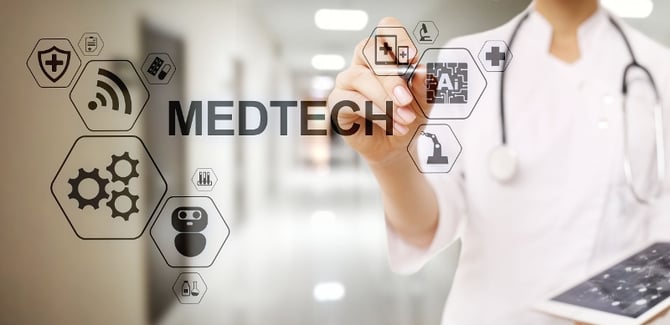Share this
microsampling in medtech: a brief introduction
by Neoteryx Microsampling on Aug 1, 2019 8:01:00 AM

Medical technology, also known as "healthtech" or "medtech," manifests in a wide range of products tailored for smarter healthcare for the human population. The innovation of these technologies is meant to improve the delivery of healthcare in a number of ways.
Earlier diagnoses - Medtech has enabled the field of medicine to be able to make earlier diagnosis of various diseases, sometimes even before the onset of any physical symptoms. As a result, this gives the patient a better fighting chance before the disease becomes more aggressive.
Reduction of time spent in hospitals - With smarter healthcare, it is possible to get and keep more detailed, more useful records of patients' histories. This enables practitioners to pinpoint a patient’s problem early enough and get to the point of treatment. This can reduce the patients' stays in hospitals.
Cost reduction - Even with health insurance, medical expenses can be substantial. Therefore, the development of devices that do not require a patient to travel to the hospital or a doctor’s office serves as a relief. This saves the patient both time and money spent taking time from work and traveling to and from the hospital. The smartest medtech devices can detect problems before they present as physical symptoms, therefore empowering practitioners to solve problems before they become more serious and much, much more potentially expensive.
Introduction of less invasive treatment options - Remote microsampling is one of the most important advancements in healthcare--for both patients and practitioners. It enables patients to self-collect their own specimen samples at home and mail them to their lab or doctor's office for testing. With microsampling, only a very small amount of fluid specimen is needed for analysis in the lab.
Using a lancet for a single prick on the fingertip, it is possible to collect a blood sample that can be used for various medical purposes. This is a less invasive method than standard blood draws, or venipuncture, where a phlebotomist typically punctures a vein in the arm to draw several tubes of blood. Microsampling requires only a tiny volume of blood, yet can deliver results correlating with those associated with plasma and venipuncture.
The microsampling approach ensures comfort for patients, reliable lab results for clinicians, and it also works in concert with other innovative medtech solutions to make telemedicine possible.
Big changes are being predicted for the next ten years of healthtech and medtech. Microsampling technology has already prompted breakthroughs in patient monitoring. Now more and more new medtech solutions will include microsampling as a necessary component.
Learn more:

Share this
- Microsampling (206)
- Research, Remote Research (119)
- Venipuncture Alternative (105)
- Clinical Trials, Clinical Research (83)
- Mitra® Device (73)
- Therapeutic Drug Monitoring, TDM (51)
- Dried Blood Spot, DBS (39)
- Biomonitoring, Health, Wellness (30)
- Infectious Disease, Vaccines, COVID-19 (24)
- Blood Microsampling, Serology (23)
- Omics, Multi-Omics (21)
- Decentralized Clinical Trial (DCT) (20)
- Specimen Collection (18)
- Toxicology, Doping, Drug/Alcohol Monitoring, PEth (17)
- Skin Microsampling, Microbiopsy (14)
- hemaPEN® Device (13)
- Preclinical Research, Animal Studies (12)
- Pharmaceuticals, Drug Development (9)
- Harpera Device (7)
- Industry News, Microsampling News (5)
- Antibodies, MAbs (3)
- Company Press Release, Product Press Release (3)
- Environmental Toxins, Exposures (1)
- July 2025 (1)
- May 2025 (1)
- April 2025 (2)
- December 2024 (2)
- November 2024 (1)
- October 2024 (3)
- September 2024 (1)
- June 2024 (1)
- May 2024 (1)
- April 2024 (4)
- March 2024 (1)
- February 2024 (2)
- January 2024 (4)
- December 2023 (3)
- November 2023 (3)
- October 2023 (3)
- September 2023 (3)
- July 2023 (3)
- June 2023 (2)
- April 2023 (2)
- March 2023 (2)
- February 2023 (2)
- January 2023 (3)
- December 2022 (2)
- November 2022 (3)
- October 2022 (4)
- September 2022 (3)
- August 2022 (5)
- July 2022 (2)
- June 2022 (2)
- May 2022 (4)
- April 2022 (3)
- March 2022 (3)
- February 2022 (4)
- January 2022 (5)
- December 2021 (3)
- November 2021 (5)
- October 2021 (3)
- September 2021 (3)
- August 2021 (4)
- July 2021 (4)
- June 2021 (4)
- May 2021 (4)
- April 2021 (3)
- March 2021 (5)
- February 2021 (4)
- January 2021 (4)
- December 2020 (3)
- November 2020 (5)
- October 2020 (4)
- September 2020 (3)
- August 2020 (3)
- July 2020 (6)
- June 2020 (4)
- May 2020 (4)
- April 2020 (3)
- March 2020 (6)
- February 2020 (3)
- January 2020 (4)
- December 2019 (5)
- November 2019 (4)
- October 2019 (2)
- September 2019 (4)
- August 2019 (4)
- July 2019 (3)
- June 2019 (7)
- May 2019 (6)
- April 2019 (5)
- March 2019 (6)
- February 2019 (5)
- January 2019 (8)
- December 2018 (3)
- November 2018 (4)
- October 2018 (7)
- September 2018 (6)
- August 2018 (5)
- July 2018 (8)
- June 2018 (6)
- May 2018 (5)
- April 2018 (6)
- March 2018 (4)
- February 2018 (6)
- January 2018 (4)
- December 2017 (2)
- November 2017 (3)
- October 2017 (2)
- September 2017 (4)
- August 2017 (2)
- July 2017 (4)
- June 2017 (5)
- May 2017 (6)
- April 2017 (6)
- March 2017 (5)
- February 2017 (4)
- January 2017 (1)
- July 2016 (3)
- May 2016 (1)
- April 2016 (2)


Comments (1)